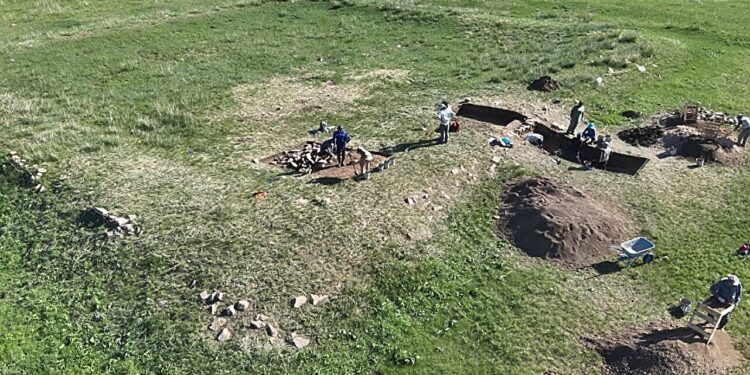Aerial photography of the square garrison and the archaeologists excavated there. Credit: Tal Rogovski
Archaeologists searched a medieval border garrison in Mongolia, suggesting that certain monumental walls on the Eurasian steppe have not been built to defend themselves against enemy attacks, but rather to control the movement of people and display dynastic power.
The large wall of China is perhaps the best known, but it is far from being the only wall system built in northern East Asia. The various groups of this border have built many physical obstacles to serve as functional and symbolic boundaries for their empires.
The least known of them is perhaps the system of medieval walls (MWS), a network of walls, trenches and boxes extending over 4,000 kilometers in certain parts of China, Mongolia and Russia. It was built from the 10th to the 12th century AD by several dynasties, notably the Jin dynasty, founded by Jarchhen of Siberia and northeast of China.
To shed light on the poorly understood MWS, researchers from the Israeli, Mongolian and American institutions have studied its 405 -kilometer long Mongolian section, known as the Mongolian Arc, and excavated at one of its enclosures. Their results are published in Antiquity.
-
Serious inside the garrison. Credit: Gideon Shelach-Lavi
-
Structure before excavations. Credit: Tal Rogovski
“We have sought to determine the use of the Mongolian enclosure and arc,” said the main research author, Professor Gideon Shelach-Lavi of the Hebrew University of Jerusalem. “What was its function? Was it mainly a military system designed to defend itself against the invasive armies, or was it intended to control the most external regions of the Empire by managing the border passages, by attacking civil disorders and preventing raids on a small scale?”
During the excavation, the team was surprised to note that, unlike the thick stone walls of the enclosure, the structure passing along the Mongolian arc itself was not at all a wall, but rather a relatively shallow ditch accompanied by a pile of earth.
Map showing the extent of the MWS and the location of the garrison (MA03). Credit: Dan Golan
This ditch would not have been particularly effective on the defensive, but it could have act as a powerful symbol, marking the area under the direct control of the Jin dynasty.
This may also have helped channel the movement of people to the doors where it was easier for them to cross. The dense distribution of the forts along the trench line would have allowed the parked people to monitor who crossed and stop them if necessary.
This indicates that the Mongolian arc, and perhaps more of the MWS, was not mainly military in nature but rather civil. MW sections were probably more concerned with managing the circulation of people, animals and goods, rather than defense against large -scale external attacks.
Excavation of the stone platform with the fireplace. Credit: Tal Rogovski
In addition, the excavation discoveries, including coins from the Song dynasty, many iron artefacts and a heated stone platform that has been used as a stove and bed, indicate that significant resources have been invested in the construction and maintenance of the garrison.
Above all, this implies that the medieval powers of East Asia have given great value to civil infrastructure, not only military, at their borders, willing to invest significant resources to publicly display their power and facilitate trade through the steppe.
This also has implications for our understanding of how ordinary people lived in such a hard and distant environment.
“Considerable investments in the walls of the garrison, as well as in the structures in them, suggest an occupation all year round,” concludes Professor Shelach-Lavi. “The future analysis of the samples taken from this site will help us to better understand the resources used by people parked at the garrison, their diet and their lifestyle.”
More information:
Life along the medieval border: archaeological surveys of the long southeast wall of Mongolia, Antiquity (2025). DOI: 10.15184 / AQY.2025.49
Quote: The other big wall? Exploration of the medieval wall system of Asia (2025, May 28) recovered on May 29, 2025 from
This document is subject to copyright. In addition to any fair program for private or research purposes, no part can be reproduced without written authorization. The content is provided only for information purposes.



